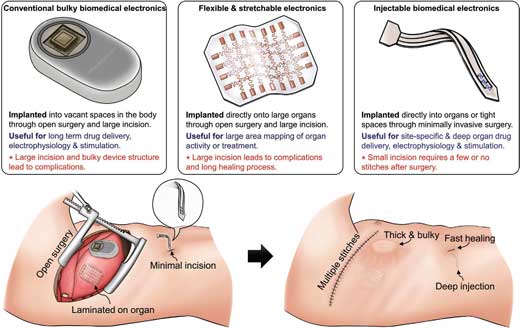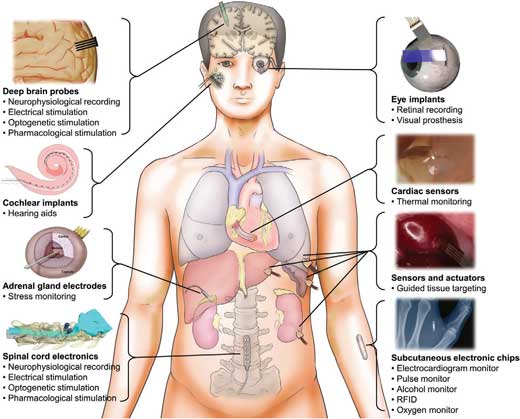Inject biomedical electronics to monitor and treat human organs
QQ Academic Group: 1092348845
Detailed
| Implantable electronic devices range from sensors, gastric and cardiac pacemakers, cardioverter defibrillators to brain, nerve and bone stimulators. These devices are connected to the human body to extract accurate medical data and interfere with tissue functions by providing electrical stimulation. Long-term implants present specific engineering challenges, including low energy consumption and stable performance. In addition, most electronic materials have poor biocompatibility and cell compatibility, leading to immune reactions and infections. | |
| Initially, electronic devices that could interact with the human body were based on flat, rigid, and bulky silicon wafer devices, and were not suitable for interacting with the soft, curved, and dynamic environments presented by biology. In order to overcome these problems, one of the categories of equipment made by the researchers is a relatively novel, miniaturized needle-shaped carrier in a high aspect ratio structure. They are used to deliver tiny sensors and stimulation tools in the body through minimally invasive injection or insertion into specific areas of the organ. | |

|
|
| Compare various forms of the latest implantable electronic products. (Reprinted with permission from Wiley-VCH Verlag) (click on the image to enlarge) | |
| In a recent review of advanced materials ( “sensing and stimulating internal body organs for injectable biomedical devices” ), the latest developments in materials, design and manufacture of injectable biomedical devices, and highlighting feasible clinical tools, Unique applications and demonstrations are applied to various internal organs. | |
| Injectable biomedical equipment is a rapidly developing field driven by advances in semiconductor technology, which allows the conversion of wafer-based electronics and optoelectronics manufactured at the micron and nanoscale to high aspect ratio forms. | |
| So far, various types of biomedical devices in the form of high aspect ratios have been applied to almost all body parts. For example, deep brain stimulation uses metal or silicon electrodes in the shape of a high aspect ratio, injectable form, targeting neurons in deep brain regions, while minimizing damage to other brain regions. The ultra-thin needle-shaped eye implant can replace the damaged retina inside the eyeball through the smallest surgical opening, otherwise it will cause the vitreous fluid to leak. | |

|
|
| Human anatomy and different types of injectable biomedical equipment are used to sense and stimulate internal organs. Deep brain probes can provide functions to record and stimulate the brain without damaging neuronal tissue. The cochlear implant‘s pluggable electrodes convert external sound into electrical signals to aid hearing. A polymer probe injected into the adrenal gland measures cortisol levels to monitor pressure. Insert soft electronics into the spinal cord to measure neuronal activity and stimulate neurons. Visual restoration can be achieved using a flexible optoelectronic system injected through the eye. An injection temperature sensor can accurately detect lesions along the heart wall. The piezoelectric device placed on the injectable probe provides a tissue mechanism for cancer targeting. The hypodermic injection device can record, track and stimulate human body information in a safe and reliable manner. (Reprinted with permission from Wiley-VCH Verlag) (click on the image to enlarge) | |
| Microelectromechanical systems (MEMS) can also be implemented in these wafer-based injectable biomedical devices to create complex 3D geometries, such as fluid channels and optical waveguides. Recently, the ability to manufacture such advanced devices on polymer substrates has created a low-cost and thinner form of needle for mechanical compliance operations in vivo. By transferring and printing various devices to the polymer needle tip, different sensor types and simulation tools can be operated simultaneously. | |
| For optical stimulation, optical fibers dominate deep tissue stimulation. Recent developments in fiber technology embed electronic tools other than optical waveguides into fibers, such as electrodes and microfluidic channels, all within micron-scale fiber diameters. Mesh electronic devices for injectable syringes can be used to achieve efforts to further reduce the size of the device to the nanoscale. | |
| Conventional syringe needles can be used to inject metal electrodes and semiconductors in the form of nanowires and nanogrids deep into human body parts because their physical dimensions are very small and cannot be placed inside the syringe needle. | |
| Integrating multiple electronic and optoelectronic functions in a micro-needle architecture requires an understanding of both conventional microfabrication processes and relatively new manufacturing methods, such as transfer printing, thermal stretching, and polymer molding techniques. | |
| Over the past decade, advances in multi-material structure manufacturing technology have led to an increase in the number of multifunctional, high aspect ratio biomedical tools. In this review, the author describes the latest developments in these injectable biomedical devices used in various parts of the human body, reviews the strategies used to achieve these goals, and the different types of materials and electronic devices developed for various applications. especially: | |
|
|
|

|
|
| Injectable electronics combined with brain optoelectronics and microfluidics. Left: Multi-channel neural probe with embedded microfluidic channels for simultaneous in vivo neural recording and drug delivery. The SEM image of the fabricated nerve probe shows the tip of the calf with 8 iridium microelectrodes and microfluidic outlets. Middle: A silicon 2D photoelectrode array that can use SU-8 as a waveguide core to transmit light to multiple locations. The SEM image of the fabricated electrode shows a single handle tip with an optical waveguide core and a microelectrode array. Right: Monolithic integrated μ-LED on silicon nerve probe. Image of implantable silicon nerve probe with recording electrodes and integrated μ-LED (inset, scale bar, 15 μm). (Reprinted with permission from Wiley-VCH Verlag) (click on the image to enlarge) | |
| Finally, the authors warn that many of the research results they reviewed are preliminary feasibility tests for new electronic products with high aspect ratio designs. Further research and development in optimizing design and function should prepare a review of injectable biomedical tools for human trials. | |
| They also summarized potential problems and suggested solutions related to the development of injectable biomedical electronics, and emphasized that more work needs to be done before long-term use of these devices before they are ready for clinical use Security assessment. | |
| Another challenge of injectable biomedical electronics is the elimination of wires used to acquire data or provide power. So far, due to the lack of wireless communication capabilities, the practical application of new biomedical electronics has been delayed because they are difficult to target organs deep in the human body, so it is particularly difficult. Commercially successful devices, such as cochlear implants and pluggable heart monitors, have wireless capabilities; however, these devices include rigid electronic chips that need to be packaged in a relatively bulky design. |
Source of information: Nanowerk
- Previous: J. Am. Chem. Soc. Revi
- Next: A Rising 2D Star: Nove


 Academic Frontier
Academic Frontier